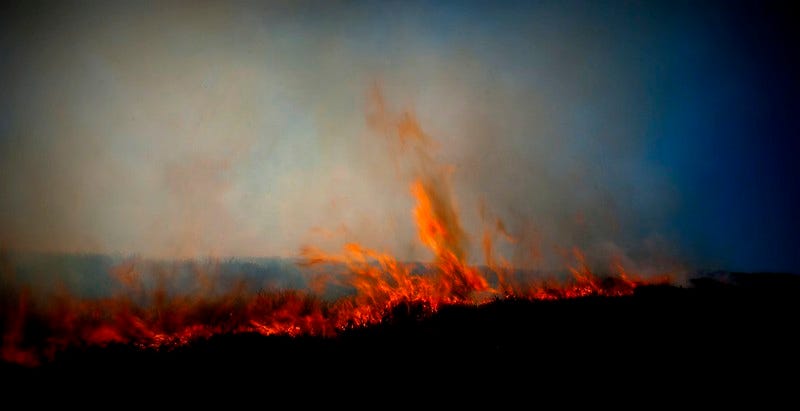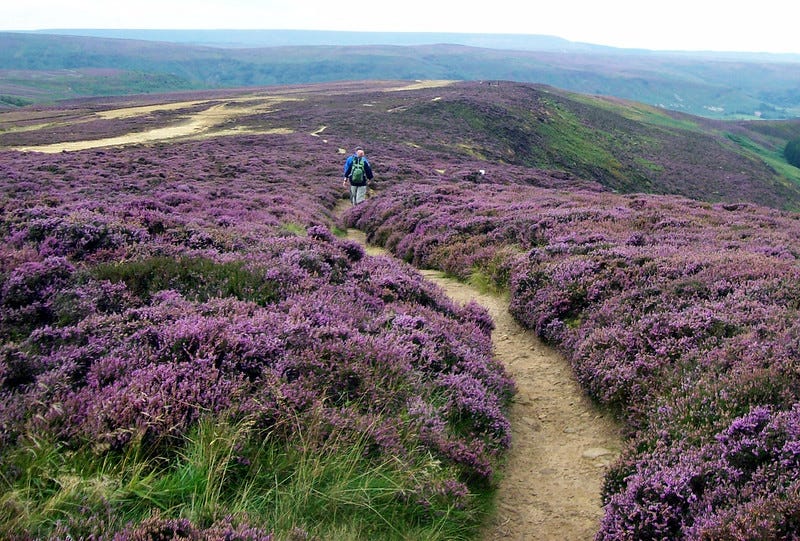Welcome to Inkcap, a newsletter about nature, ecology and conservation in the UK, written and reported by me, Sophie Yeo.

This is your Wednesday feature. You can still read last Friday’s digest: Tory Nature Pledge & Raptor Crime.
Today’s article is being co-published in The Manchester Mill, a brilliant new newsletter producing quality journalism about Greater Manchester. You should definitely subscribe if you live in the area; if you don’t, at least read this wonderful article about the greening of Manchester’s alleyways.
As ever, you can support my reporting at Inkcap by signing up as a paid subscriber.
Stay happy and healthy, and I’ll be back in your inbox on Friday, as usual.
As the full moon rose above the burning hills, the local MP was reminded of Mordor, the volcanic realm from Lord of the Rings.
“It looked apocalyptic,” said Jonny Renolds, who represents Stalybridge, at the time. At that point, the fires had been burning for three days. They would continue to burn for another three weeks.
The Saddleworth Moor fires broke out in the summer of 2018, rapidly engulfing thousands of acres of moorland around Greater Manchester and Lancashire.
It was the largest wildfire incident close to an urban population on record in the UK. More than 50 homes had to be evacuated as ash fell from the sky; residents were advised to keep their windows shut and tune into their local radio station for further information.
Wildfires remain outside the direct experience of most people in the UK, even as they rage with increasing ferocity in Australia and America. That is changing as the climate heats up; drier summers are expected to increase the frequency and size of these events.

But climate change is only one chapter in the UK’s complex relationship to wildfire. In fact, the UK’s moorlands have been drying out for centuries, the squelchy bogs in which one might easily lose a boot gradually transformed into stiff mud through traditional management techniques.
Humans have used fire to shape the landscape for millennia. Often, it is a necessary tool for both the natural regeneration of the landscape and to prevent the kinds of fearsome wildfires that are ripping through the American west at the moment.
However, the use of fire in the English and Scottish uplands is more controversial due to one complicating factor: peat.
After forests have burned, they eventually grow back. That is not the case with peatlands, ancient soils formed of partially decayed material. While other parts of the uplands have formed through centuries of deforestation and overgrazing, these peatlands are generally climax habitats – the natural endpoint of millennia of ecological succession.
Among many pressures on this ecosystem is the fact that gamekeepers, since the Victorian era, have routinely drained bogs and burned strips of heather, forging through fire a patchwork of habitats in which gamebirds can thrive – and then, come the so-called Glorious Twelfth, be shot.
In the dry and degraded state caused by regular managed burns, these peatlands are flammable. Once burning, wildfires can penetrate deep into the soil, releasing the rich reserves of carbon and contributing to climate change.
The Saddleworth Moor fire started on the Stalybridge Estate, a grouse moor, and spread across a large area of the Pennines. While police attributed the blaze to arson, campaigners have pointed out that the degraded peatlands likely contributed to the severity of the wildfire; the blanket bog has recently undergone restoration and was “beginning to breathe again,” according to Moors For The Future.
The first flames were extinguished swiftly by both firefighters and gamekeepers, but then reignited with the dawning of another hot summer’s day.
“They hadn’t put it out properly. That fire could have been, and should have been, extinguished, but the Fire Service didn’t really understand how peat burns,” says Pat Thompson, senior uplands policy officer for the RSPB. “You think the fire is out, but those little pockets of peat may still be smouldering beneath the surface.”
Whether fire should be used to manage the UK’s moorlands, which consists of a variety of habitats, is a subject of fierce debate; the answer usually depends on how you feel about grouse moors, and whether you believe that the uplands should be conserved in their current state or allowed to revert to scrub and woodland. When it comes to peatland specifically, however, there is greater consensus: burning does not belong here.

It is a view echoed by both campaigners and politicians. Last year, environment minister Zac Goldsmith said that the government was developing legislation to ban burning on peatlands, although this has been slow to materialise.
“We have always been clear of the need to phase out rotational burning of protected blanket bog to conserve these vulnerable habitats, and we are looking at how legislation can achieve this,” confirmed a Defra spokesperson.
But given that a promised England Peat Strategy has been repeatedly delayed, campaigners are not optimistic. (In the same statement, Defra said that the government intends to publish the strategy later this year.)
The government’s independent advisory body, the Committee on Climate Change, has also called for a ban on peatland burning. The RSPB also supports a ban, reiterating their call as this year’s burning season kicked off on 1 October.
One of the principle arguments in favour of continuing burns on grouse moors is that it reduces the volume of vegetation that fuels these ferocious wildfires.
“With red grouse moor management comes vegetation management through mowing and rotational burning,” according to the Moorland Association, a group representing moorland owners. “The risk of a severe wildfire is lower due to a reduced amount of vegetation available to burn.”
But it’s an argument that fundamentally misunderstands the nature of a healthy peatland, says Clifton Bain, director of the IUCN UK Peatland Programme. “The heather on those peat areas shouldn’t be growing so prolifically. It’s a sign that the bog has been degraded,” he says.
“When you burn damaged peatland, you reduce the amount of woody material for a while, but you’re keeping the peatland damaged. They’re missing the point that there’s a better solution than just perpetuating that dry state, and that is to make it wet. You get more wildlife, less carbon loss – and the really crucial point is that, when you rewet a peatland, it isn’t vulnerable to drastic fire.”

For Claire Belcher, professor of wildland fire at the University of Exeter, the solution lies somewhere between the two approaches. She doesn’t support the ban on peatland fires; she regards prescribed burns as a useful management tool while these ecosystems are moving towards a healthier state, when the soil is becoming wetter but the dry heather has yet to die off.
“In theory, if you could rewet enough landscape, you may not have fires. But I think if we’re looking into the future – to 2100 – there still will be days where surface fuel is dry enough,” she says. “It still needs to be discussed whether appropriate fires can be used to manage these areas, at least as they transition to the healthy peatland that they want.”
But she also stresses that these kinds of prescribed fires are different to burning tracts of heather across a shooting estate. “The ecology of these landscapes is much more difficult than just starting fires to remove fuel and create patchy landscapes for grouse management,” she says.
The Saddleworth Moor fires were large, but they are still part of a wider pattern: last year was the UK’s worst fire season, by area burned, in eleven years. This is not just a disaster for wildlife and the climate but for people, too. Researchers found that the Saddleworth Moor fires caused air pollution to spike across Manchester, Liverpool and Wigan; concentrations of tiny particles known as PM2.5 climbed to twice the limit recommended by the WHO.
“There are likely to have been considerable negative health impacts for individuals exposed, particularly for those with underlying health conditions,” the researchers wrote.
Nobody benefits if the UK’s precious peatlands go up in smoke. Climate change is a global problem, but responsibility for these ancient ecosystems lies with us. These soils store everything from carbon to preserved human bodies from the Iron Age. Here’s to more storage, more skeletons, and more lost boots.
Inkcap is 100% reader-funded.
If you value independent environmental journalism, please consider supporting Inkcap by becoming paid subscriber. (If it takes you to the landing page, simply re-enter your email.)
Got an opinion? Leave a comment, or get in touch by replying to this email.
Image credits: Snipps Whispers, summonedbyfells, Natural England



Sad this year to see that 150 acres at Thursley were lost to wildfire. The recovery of species may take years.